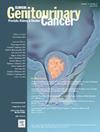Impact of Extended Versus Limited Lymph Node Dissection on Surgical Outcome, Recurrence Patterns and Survival After Radical Cystectomy
IF 2.7
3区 医学
Q3 ONCOLOGY
引用次数: 0
Abstract
Background
The aim of our study is to evaluate the impact of extended versus limited lymph node dissection (LND) in patients undergoing radical cystectomy (RC) on survival, perioperative outcomes and pattern of recurrence.
Patients and methods
We reviewed our charts to identify patients who underwent RC and LND with curative intent between January 2003 and November 2022. Standard open RC with limited or extended LND was routinely performed, depending on surgeon's preference. The upper limit of extended LND is usually the ureteral crossing with the common iliac artery, unless further extension to the aortic bifurcation or inferior mesenteric artery is clinically indicated. Whereas limited LND includes removal of external and internal iliac and obturator Lymph nodes (LNs). The primary outcome was to compare the 2 patient groups in terms of cancer-specific survival (CSS) and overall survival (OS). The secondary outcome was to assess the impact of the extent of LND on the pattern of recurrence (local and distant metastasis free-survival) and perioperative complications.
Results
Of 642 patients, 439 and 203 underwent limited and extended LND, respectively. In the extended LND group, the median number of LNs removed was 23 compared to 8 in the limited LND group (P < .001), which was associated with higher median positive LNs in the extended group (3 vs. 2, P = .05). Extended LND was associated with longer operative time (300 vs. 250 min., P < .001), but not with blood loss, postoperative hemoglobin drop, hospital stay, 90-days major complications and hospital readmission rates. Lymphocele requiring surgical intervention was higher in extended group (7.4% vs. 1.8%, P = .001). The median follow-up time of survivors was 41 months in the limited group and 52 months in the extended group, (P = .1). Overall, 127 (29%) and 52 (26%) patients in the limited and extended groups experienced clinical recurrence (P = .39). At multivariable Cox regression analysis, LND template was not associated with either local and distant metastasis-free survival or CSS, while resection of ≥16 LNs was an independent predictor of local recurrence-free survival (HR 0.54; P = .01) and CSS (HR 0.6; P = .002), regardless of the dissected template. Both extended LND (HR 0.63; P = .004) and resection of ≥16 LNs (HR 0.66; P = .003) were associated with improved OS.
Conclusion
The number of LNs removed appears to be more important than the LN template in patients undergoing RC. Resection of at least 16 LNs is associated with better cancer control and oncologic outcome.
扩大与有限淋巴结清扫对根治性膀胱切除术后手术结果、复发模式和生存的影响
本研究的目的是评估接受根治性膀胱切除术(RC)的患者进行广泛和有限淋巴结清扫(LND)对生存率、围手术期结局和复发模式的影响。患者和方法我们回顾了我们的图表,以确定2003年1月至2022年11月期间接受RC和LND治疗的患者。根据外科医生的喜好,常规进行标准的开放RC和有限或扩大的LND。延伸LND的上限通常是输尿管与髂总动脉相交,除非临床指征进一步延伸至主动脉分支或肠系膜下动脉。而有限的LND包括切除髂内外及闭孔淋巴结(LNs)。主要结局是比较两组患者的癌症特异性生存期(CSS)和总生存期(OS)。次要结果是评估LND的程度对复发模式(局部和远处转移无生存)和围手术期并发症的影响。结果642例患者中,439例行有限LND, 203例行延长LND。在扩展LND组中,切除的中位ln数为23个,而有限LND组为8个(P <;.001),扩展组中位阳性LNs较高(3 vs. 2, P = 0.05)。延长的LND与更长的手术时间相关(300 vs 250分钟,P <;.001),但与出血量、术后血红蛋白下降、住院时间、90天主要并发症和再入院率无关。延长组需要手术干预的淋巴囊肿发生率更高(7.4%比1.8%,P = .001)。存活者的中位随访时间,限制组为41个月,延长组为52个月,差异有统计学意义(P = 0.1)。总的来说,有限组和扩展组分别有127例(29%)和52例(26%)患者出现临床复发(P = 0.39)。在多变量Cox回归分析中,LND模板与局部和远处无转移生存或CSS无关,而切除≥16个LNs是局部无复发生存的独立预测因子(HR 0.54;P = 0.01)和CSS (HR 0.6;P = .002),与解剖模板无关。两者均延长LND (HR 0.63;P = 0.004),切除≥16个LNs (HR 0.66;P = .003)与OS改善相关。结论切除LN的数量比切除LN模板更重要。切除至少16个淋巴结与更好的癌症控制和肿瘤预后相关。
本文章由计算机程序翻译,如有差异,请以英文原文为准。
求助全文
约1分钟内获得全文
求助全文
来源期刊

Clinical genitourinary cancer
医学-泌尿学与肾脏学
CiteScore
5.20
自引率
6.20%
发文量
201
审稿时长
54 days
期刊介绍:
Clinical Genitourinary Cancer is a peer-reviewed journal that publishes original articles describing various aspects of clinical and translational research in genitourinary cancers. Clinical Genitourinary Cancer is devoted to articles on detection, diagnosis, prevention, and treatment of genitourinary cancers. The main emphasis is on recent scientific developments in all areas related to genitourinary malignancies. Specific areas of interest include clinical research and mechanistic approaches; drug sensitivity and resistance; gene and antisense therapy; pathology, markers, and prognostic indicators; chemoprevention strategies; multimodality therapy; and integration of various approaches.
 求助内容:
求助内容: 应助结果提醒方式:
应助结果提醒方式:


